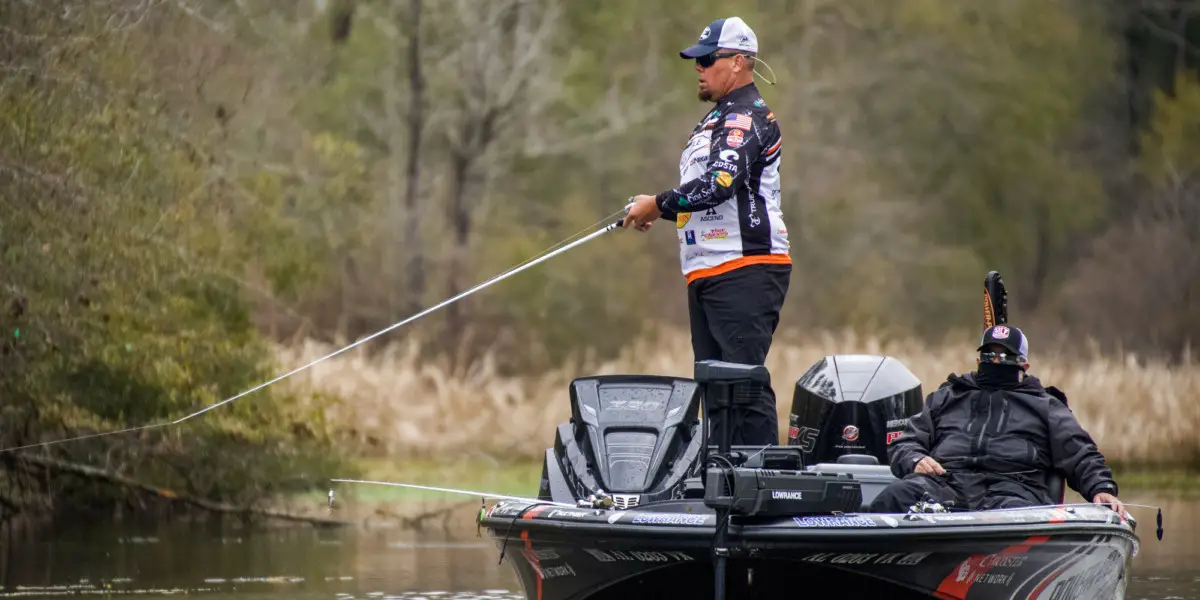Most anglers agree that one of the most exhilarating experiences in the sport of fishing is hitting a predatory fish on the surface of the water. Watching and catching a big fish hit your lure is a pretty cool experience but you will need the right kind of equipment and knowledge to do it. What is topwater fishing?
Topwater fishing uses special equipment & techniques that are designed to work with topwater lures that float on the surface of the water. Poppers, Plugs, & Prop Baits Lures are cast & retrieved on topwater mimicking, the color noise & shape of insects, small fish, or other food predatory fish prey on.
Rod Setup and fishing tackle equipment are just as important as the right topwater Lures and technique and hopefully, this article can help you with the skill you need to become better at fishing on the top surface of inland water for the most exciting and effective way to fish from a boat or the lake shore.
What is Topwater Fishing
To fish topwater lures the most natural way on the surface of any type of water you’ll need the best topwater rod setup. With the right rod & reel fishing setup, you’ll get the best action and feel from your topwater lure as it walks back to you on the surface of the water.
If you are doing a lot of casting it’s important that you are comfortable with the length of your fishing rod otherwise things will get sloppy like losing control of the rod tip hitting the water or catching the boat on a throw.
Use a Carbon Medium-Action stiff fishing rod that is around 6ft 10 in long. Try to find something between 6’4″ to 7 ft just a bit shorter is actually better for most topwater lures. This allows for more cadence or action when working any type of Topwater lure on the water. It also adds more control for the user that longer-type rods don’t have.
Choose a fishing rod with a shorter butt section that also contributes to controlling the action, keeping the rod closer to your body which then helps gives a crankbait or topwater lure more presentation and movement. If you want to throw heavier lures try a little bit longer rod, like 7’4″ medium-heavy action for stepping up. Good for casting farther and for bigger baits Buzzbaits, frogs, and swim jigs it just adds more versatility.
Use a light action reel 5:1 gear or better yet 7:1 ratio with a higher speed gear ratio. With the ability of a slower presentation that is ideal for crankbaits and other high resistance lures Abu Garcia 1430443 Revo Winch Low Profile Baitcasting Reel, 5.4: 1 Gear Ratio, 22″ Retrieve Rate, 24 lb Max Drag, 9 Bearings, Right Hand
Use a loop knot at the end of your lure that keeps the Topwater lure up on the top of the surface of the water giving it a better presentation that you are able to see as you bring it in. It will free the lure up making it retrieve more naturally.
Use a 14-17 lb. test Monofilament leader on the Braid line that will keep the line stiff enough that it won’t come back up on the lure and wrap around the treble hooks. Smaller-pound leader for lighter lures and 17 pounds for heavier baits. The color of the line really doesn’t matter because the monofilament line will be sitting on the surface of the water where the fish can’t see it.
Topwater Baits and Topwater Fishing Lures
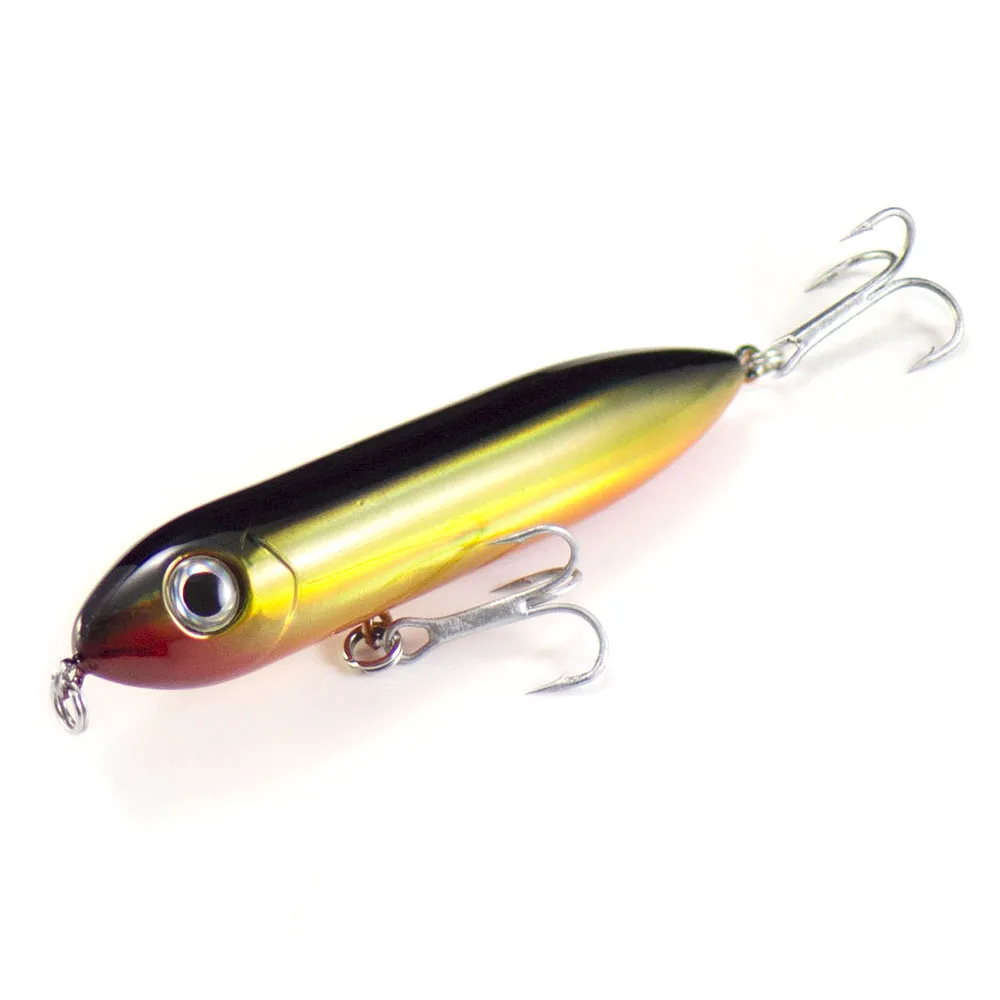
Topwater Plug lures can run any kind type of color or method of fishing With most Topwater fishing lures you want to use a monofilament leader because it doesn’t sink as fast as the fluorocarbon line keeping your lure insight and is on top of the surface.
Some anglers will remove the split ring on the nose of the lures that can make the sink and nose dive on the retrieve. Learn to tie a loop knot this will act as a split ring for the best movement on the water.
The length of the leader on the lure should be between 1 and 2 ft long and we noted earlier that the color won’t matter because the leader should be sitting on top of the surface where the fish will not see it. The length should be up to you and your situation and shouldn’t affect the action of the lure. Plug-type fishing lures are one lure that will do walking the dog-type lures that are known in topwater fishing.
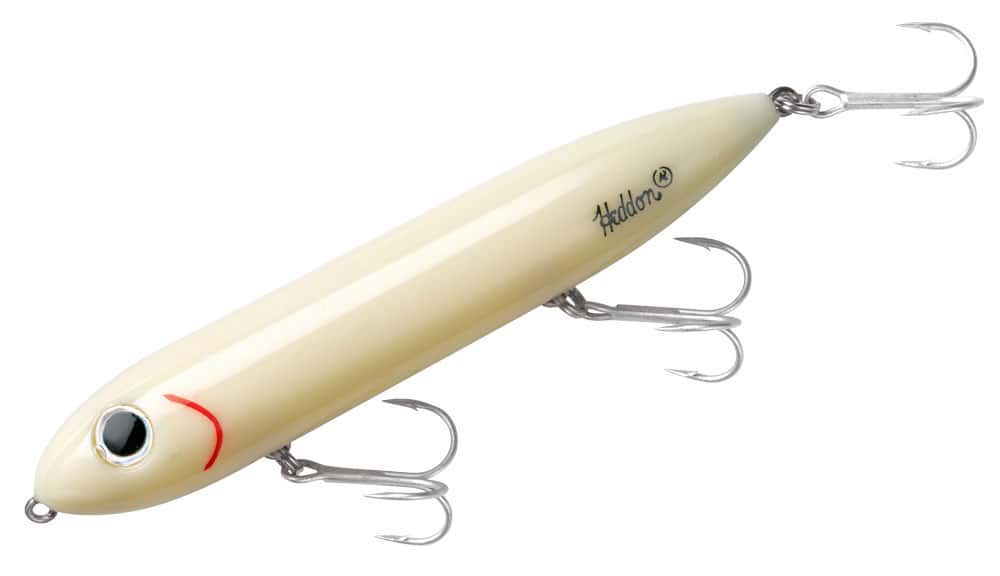
One of the most popular Topwater Fishing Lures available today is the Heddon Super Spook Bone Color The Super Spook is a glide topwater plug or a walk-the-dog style bait.
The Glide Baits are slower-moving topwater plug that doesn’t move a lot of water. Most of these Lures emulate an injured fish moving on the surface of the water.
At times Striper will key in on a less obtrusive topwater plug. Some anglers like to remove the middle treble hook, cut off one of the front treble hook barbs, and replace the rear treble hook with a single saltwater hook.
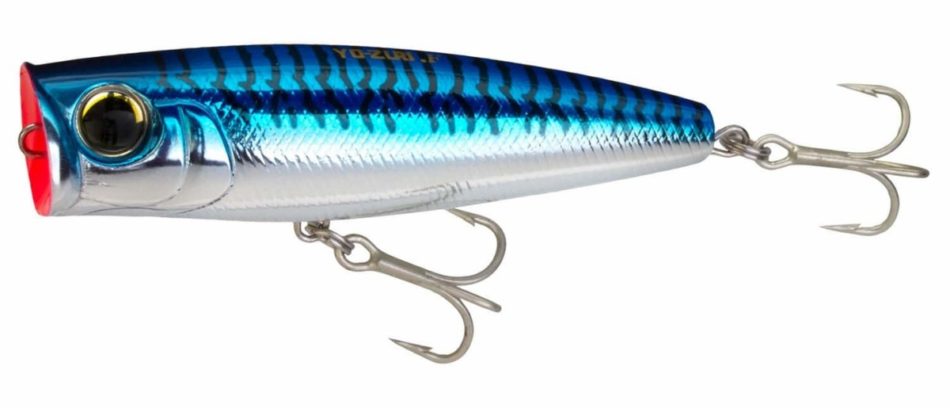 Poppers, sometimes called chuggers are hard plastic or wooden plugs with a flat or concave face. When quickly jerked, they pop, splash, and chug, which emulates prey struggling on the surface.
Poppers, sometimes called chuggers are hard plastic or wooden plugs with a flat or concave face. When quickly jerked, they pop, splash, and chug, which emulates prey struggling on the surface.
Poppers are the ideal surface bait for target fishing. They can be accurately cast and should be worked close to laydowns, docks, rocks, and anything else fish would hold on to. Poppers are excellent from post-spawn all the way through the fall. Jerk your rod tip down, in short, jerking motions. Try different cadences until you start getting bites – a pop, pop, pause, repeat cadence is a good place to start.
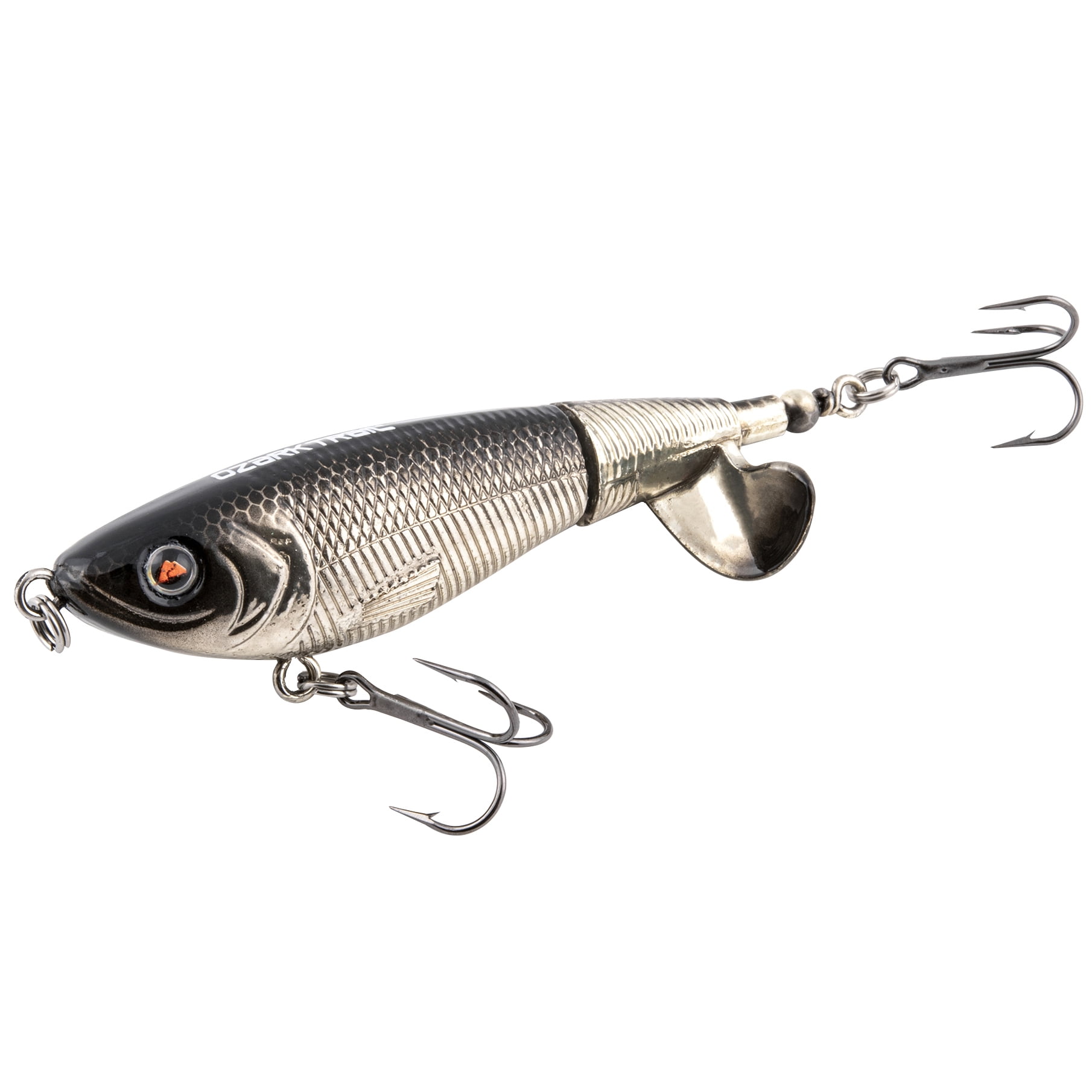
Props Plug fishing lures have a prop feature on the front or the back of the lure which helps trigger a reaction from the bigger fish you are looking for. With most Topwater lures you want to use a monofilament leader because it doesn’t sink as fast as the fluorocarbon line keeping your lure insight and on top of the surface. Experiment with the movement until the pattern catches fish keeping the lure insight.
Some anglers will remove the split ring on the nose of the lures that can make the sink and nose dive on the retrieve. Learn to tie a loop knot this will act as a split ring for the best movement on the water.
This next video will show you the best way to tie the Loop Knot giving you the best results for moving your plug on the surface of the water giving it a natural life movement for attracting predator fish. Like the guy in the video says everybody fishing with artificial lures should know how to tie this knot.
How to Tie a Loop Knot for Topwater Lures
When To Fish Topwater Lures
The art of Topwater fishing is a way of convincing and enticing a fish that may be more inquisitive than hungry. Some buzz bait fishing lures made for Topwater fishing slide across the surface water reflecting color and shining under the sun.
Other lures will kick up water splashing their way back to your rod while others like the Prop Lures which are great topwater fishing lures sputter and splash creating a surface commotion when retrieved and providing a visual and audible focus for a fish to key in on.
Making noises that a predatory fish like a Bass just can resist an investigation to find out what is passing his home. Once they key in on it they just can’t leave it without taking a nip. BANG- Fish On!
Topwater baits primarily are successful during early morning and evening periods. They have also been found by pro anglers to be effective during hot weather periods, especially when fish are in ambush mode and tight to cover. Sometimes they proved useful during rainy and overcast days, especially when fish are super hungry. Still, good times to use topwater lures are:
- Fish with topwater lures throughout the day, not only during “prime times.”
- Fish them around shallow cover where bass
- Prop Baits with rattles can help call fish in, especially during murky water conditions.
- Use Natural colored baits are a good bet during clear water fishing environments.
- Topwater fish lures during the midnight hour can account for big fish
- Use fishing Lines that won’t stretch because these no-stretch lines allow for easier hook sets, especially on long casts.
- Concentrate on or close to cover, especially with largemouth bass they will usually be close.
- Warm summer temperatures at night and daytime
Bass Topwater Fishing
The best topwater fishing tips that I heard and have proven themselves fishing over the years and the best to learn. Never set the hook on the initial strike. Although it may seem like the thing to do, it will usually end up with a lure flying back at the angler full steam.
Wait for a second or two for the fish to turn with your lure before setting the hook. This extra wait will result in much more fish on the boat. Remember when it is time, set that hook hard.
If most of your fishing is for Largemouth Bass, they hit topwater the best in early spring, between February and March depending on the location. Bass is found in topwater when there are low periods of light, during dusk and dawn, and not quite night fishing.
In early spring, Largemouth can also be found at noon and mid-afternoon. Post-spawn is considered the best time to throw topwater lures.
A buzzbait is similar to a spinnerbait, but with a triangular-shaped delta blade, which causes it to lift and sputter, spit, and squeak on the surface. Buzzbaits can be effective on topwater lake fishing and dynamite any time the bass are feeding around shallow cover and are relatively weedless which allows them to be fished in some pretty thick stuff. Buzzbaits are one of the earliest topwater lures to become effective and can be fished from pre-spawn all the way through the fall.
Fishing topwater with lures designed to float above the surface of shallow water, especially ones that are designed to float above the surface of shallow water, can be exciting when looking to catch bass. There are bass fishing lures that can travel close to the bank of a reservoir or lake, like a frog bait, that are very effective along with a topwater plug that will fish topwaters and is designed to float above the surface of shallow water without snagging
How To Use Topwater Lures in Saltwater
Fishing Topwater lures can be effective all year long, and most anglers usually have one rod rigged with a topwater lure whenever on the saltwater. designed to float above the surface of shallow water designed to float above the surface of shallow water just as Topwater fishing in freshwater. Effective from a boat and catch and release. Saltwater topwater lures are used in Florida for tarpon sports game fishing.
They’re great because fishing Topwater:
- Can elicit a reaction strike because they resemble an injured baitfish
- You can use them to cover a lot of water
- Predator fish like bass can easily ambush baitfish on the surface because they have nowhere else to go
However, even though topwater works well, they don’t catch fish all the time.
Throwing these topwater lures is best when there is not a lot of sunlight, including:
- At sunrise
- At sunset
- If there is lots of cloud cover
There are a few reasons as to why topwater lures work best at low light conditions, but one is that when the sun is high and bright, they’re blinded by the sun when they try to look up to the surface. When the sun is up high, you’ll want to avoid using topwater lures and instead use a lure such as soft plastic.
JimGalloway Author/Editor

